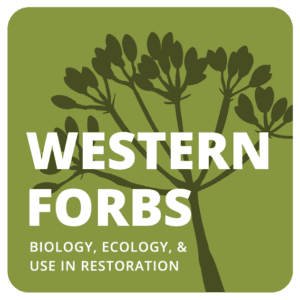Restoration
View webinar recording.
The South Central Climate Adaptation Science Center (SC CASC) highlighted one of their funded projects, Time to Restore: Connecting People, Plants, and Pollinators, through the webinar series – The Southern Plains Climate Science Webinar Series.
Watch to learn how this project involves the pollinator restoration community through the entire process to assist them with climate-informed guidance on the timing of nectar plant flowering and seeding. Better knowledge of climate impact on flowering and seed timing for critical nectar plants can inform more resilient restoration plantings.
Jane Breckinridge, the Director of the Tribal Alliance for Pollinators, and Erin Posthumus, the Outreach Coordinator for the USA National Phenology Network and the Principle Investigator of this SC CASC-funded project, will share their perspectives on this project which recently received a second funding award to continue their work.
View videos.
Native Seeds: Supplying Restoration is a nine-part video series that explores the native seed supply chain in the western United States. Filmed over four seasons, this series weaves together footage of seed collectors, farmers, researchers, and land managers working to scale up the supply of native seeds to meet the growing restoration demand. We see the staggering scale of damage to vast landscapes and meet tenacious people who are finding creative, scrappy solutions to restore ecosystems.
Webinar recording.
The Bureau of Land Management (BLM), in collaboration with the Society of Ecological Restoration’s International Network for Seed-based Restoration (SER-INSR), The Nature Conservancy (TNC), and Holden Films, produced a series of educational documentaries that explore each step of the native seed supply chain in one of the largest and most sophisticated native seed markets in the world, the Western United States. Episodes of the nine-part series have been released weekly throughout the summer (June 29 – August 24, 2023) and can be viewed on ser-insr.org/native-seed-film.
In this webinar, representatives from BLM, SER-INSR, TNC, and Holden Films will discuss the production of the video series from both a scientific and cinematographic perspective and share stories of this incredible journey.
The panel discussion will be followed by a Q&A session with the audience.
Webinar recording.
This presentation examines how post-fire planting success is influenced by climatic, microclimatic, topographic, and biotic factors. Multiple seedling planting experiments across northern New Mexico were evaluated using seedling monitoring, remote sensing, drone, and microclimate data. The results show tree seedling survival in high severity burn patches is largely determined by microclimatic refugia formed by both topographic variation and existing vegetation. Using machine learning and a new index of seedling survival probability, the most suitable artificial reforestation sites can be mapped for efficient restoration planning. This presentation posits that success rates of reforestation efforts in post-wildfire landscapes could be substantially increased by considering site survivability and suitability.
View synthesis.
We synthesized restoration techniques and their effectiveness in the Mojave and western Sonoran Desert, provide estimated costs of candidate techniques, and anticipate future research needs for effective restoration in changing climates and environments. Over 50 published studies in the Mojave and western Sonoran Desert demonstrate that restoration can improve soil features (e.g., biocrusts), increase cover of native perennial and annual plants, enhance native seed retention and seed banks, and reduce risk of fires to conserve mature shrubland habitat. We placed restoration techniques into three categories: restoration of site environments, revegetation, and management actions to limit further disturbance and encourage recovery. Within these categories, 11 major restoration techniques (and their variations) were evaluated by at least one published study and range from geomorphic (e.g., reestablishing natural topographic patterns) and abiotic structural treatments (e.g., vertical mulching) to active revegetation (e.g., outplanting, seeding).
Workshop recordings.
Wet or mesic meadows are rare but disproportionately important ecosystems in Utah. Gully erosion and channel incision are widespread problems reducing natural resiliency and water storage capacity, which is impacting wildlife and working lands. Simple, low-tech restoration methods developed for dry lands of the desert southwest by Bill Zeedyk provide effective tools for protecting and restoring meadow systems. These techniques are cost-effective and hand-built allowing more people to participate in restoration.
In this one-day virtual workshop, Utah land managers and partners will be introduced to: reading the landscape to recognize meadow conservation opportunities, various low-tech “Zeedyk” structures (e.g., One Rock Dams, Zuni Bowls), project planning, implementation, and monitoring. Regional instructors will share tips and lessons learned from implementing low-tech meadow restoration projects across the West, while Utah conservation partners will discuss local opportunities and considerations.
View article.
This study investigated survival of transplanted herbaceous seedlings at different distances from Wyoming big sagebrush canopies. We planted two native perennial forb species, Munro’s globemallow and common yarrow, and two native perennial grass species, bluebunch wheatgrass and bottlebrush squirreltail, at four distances from sagebrush canopies at six sites across the Intermountain West, repeated across 2 years. Under above-normal precipitation, proximity to sagebrush influenced first-year survival of the forb, but not grass, species. Globemallow and yarrow survival were highest mid-way between the canopy dripline and maximum interspace distance between neighboring sagebrush plants. Ground cover characteristics and globemallow survival covaried with respect to distance from shrub, suggesting ground cover characteristics as indicators of suitable planting microsites. Under drier conditions, survival of all species was low and unaffected by distance from canopies. Our results demonstrate the value of fine-tuning the canopy-interspace paradigm to more carefully consider how plant performance may differ across zones within the interspace region between plants, especially when the goal is to maximize plant establishment in nondrought years.
View article.
Twelve in-depth interviews were conducted, and responses were analyzed using a qualitative method, causal layered analysis, not previously applied in a land management context. In the most superficial (litany) layer, cost and scale were prominent. The next (systemic) layer was framed by policy and bureaucracy limitations as well as technical barriers to implementation. In the third (worldview) layer, lack of a proactive management tradition within agencies represented a principal barrier. In the deepest (myth/metaphor) layer, the central belief is that human intervention should be used to protect ecosystem services only after they are disrupted due to human activity. Based on the different obstacles found at each level, we suggest ways to overcome the barriers detected.
Pre-fire grazing and herbicide treatments can affect post-fire vegetation in a Great Basin rangeland
View article.
This study found grazing and herbicide effects were consistent across cheatgrass biomass, count, and cover. Spring grazing reduced cheatgrass more effectively than fall grazing; however, this effect was detected primarily outside of the seeding treatments. Herbicide overall and in conjunction with grazing reduced cheatgrass and fuel loads. Among seeding treatments, seed mixtures proved more effective than monocultures for reducing both cheatgrass count and cover, particularly when combined with low seed rate. However, many seeding approaches resulted in higher cheatgrass dominance, and thus higher fuel loads.
The Western Forbs: Biology, Ecology, and Use in Restoration project is now a website.
Westernforbs.org is designed to aid seed collectors, seed growers, nurserymen, landowners, restoration practitioners, and land managers as they increase the supply and use of native forbs.
- Species menu tab – Offers complete reviews that synthesize existing research and practical experience available for western forb species. Anything reported on the biology, ecology, seed technology, and use in wildland restoration is included.
- Lookup Table menu tab – Summarizes forb species data in a searchable and filterable table. Included are the data on taxonomy, distribution, biology, ecology, seed supply development, and nursery and wildland restoration knowledge for each species.






